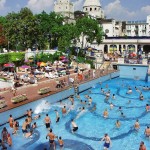I wanted to try the Lukács thermal bath because it is less well known by tourists, and is particularly popular with locals. It geothermal waters were used by the Knights of St. John, a Christian military order dedicated to caring for the sick, in the 12th Century. They were followed by the Knights Hospitallers, and the Rhodos and the Maltese Knights, who built baths next to their monasteries. The bath operated through the time of the Turks, in the 16th Century, but then the energy of the springs was used primarily to produce gunpowder and for grinding wheat.
The first spa hotel and wellness centre was built in the 1880’s, with a drinking cure hall (the "pump room") added in 1937, and a daytime hospital established in 1979 (the National Institute of Rheumatology and Physiotherapy) to treat locomotive diseases and act as a physiotherapy centre.
In 1999, the two open-air pools were modernised, and the so-called mud-pond, hardly used before, was replaced by what is endearing called the fancy pool, equipped with a river current, effervescence, neck shower, water beam back massage hidden in the seat banks, whirlpool, geysers, and effervescent bed. This is built completely surrounded by the walls of the hospital, serving as a liquid courtyard.
The primary challenge of the Lukács is to actually find the entrance. It's not far from the Buda side of the Margit bridge, across a bit of parkland and into a maze of yellow buildings. the pump room is easy to find, and its strong suphur smell hits you as you go inside to ask the attendant where the heck the pools are. Following a winding path to the end, one enters a modest door and sees a payment kiosk.
That's the primary challenge, meaning that's just the first challenge.
Once inside I followed various hallways and followed helpful hand directions to find the locker room, but no locker worked with my plastic wrist band (identical to the one at Rudas except for its colours). Ah, I have a cabin, ok, where is that? More hallways, past a pool, past more pools, and then I am directed to cabin 6. Still, the band doesn't work. Guided to another section where there is another cabin 6. ??? Oh, yeah, it gets better. There are at least two more cabin 6s dotted throughout the complex. By this time I have used up 20 minutes of my two hour time and haven't got my skivvies off.
Finally, finally, I am in and changed and have a rented towel (an exorbitant amount that I am told will mostly be returned upon departure).
Tertiary challenge was finding out where to start. The two outdoor swimming pools looked lovely but are swimming pool temperature, and it is freezing outside and starting to get dark. But I do go into the Fancy Pool - I mean who can resist not going into the Fancy Pool? It's not hot but it is warm enough to enjoy spinning along the circular water river with other adults who are smiling like children. Trying to swim against the current is a good workout, as long as you are happy enough to not make any forward headway. There are shallow sunbathing shelves with jets under and over. But the best was just to sit neck deep and look around at the lovely golden building encircling the pool. On Saturday nights there are bath parties with DJ'd music and light shows which I can imagine get pretty raucous, and which has made it more well known and popular with those less medicinally affiliated.
Getting a little chilled, I moved into the older parts, the Turkish pools that had steps, or tiled seats in them and warmer temperatures. There is a modern cold plunge pool of course,
and saunas and steam rooms as well, but the most intriguing pool to me was the Weight Bath, built for stretching the back and treating spinal injuries and "deformities". Much as I don't really consider my scoliosis a 'deformity' I suppose speaking strictly anatomically it is, so I was intrigued at the narrow deep pool with a sort of shoulder grip so that one can hang straight down in the water. If I used this every day I might get my lost 2 inches of height back. Alas, it is a one time affair so I channeled a bit of appreciation for it.
As one might expect from a hospital that provided prescriptions to the various treatments, it is accessible to the disabled. The list of therapies identified for its use are:
- traumatic aftercare
- aftercare following bone or joint operation
- the inactive stages of chronic, inflammatory locomotor disorders (eg. rheumatoid arthritis, articular diseases, Bechterew-disease)
- chronic neuritis
- nervous pains
- the inactive stages of chronic degenerative bone and joint diseases
- osteoporosis (calcium deficiency of the bones)
- degenerative joint diseases
- spinal deformity
- discus hernia
- neuralgia
- post-accident rehabilitation
The springs themselves are rich in (deep breath here) calcium hydrogencarbonate and calcium hydrogensulfite, magnesium hydrogencarbonate and magnesium hydrogensulfite, choride, sodium and fluoride ions.
I had such a good time that I did not get my towel deposit ba
ck as I was 15 minutes past my ticket time, which of course I blame wholeheartedly on the hunt for the correct and illusive cabin number 6.
 |
| good clean fun |

























